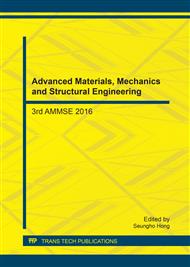p.287
p.293
p.299
p.305
p.311
p.317
p.323
p.328
p.334
Failure Analysis of the Laser-Welded Web-Core Steel Sandwich Panel with Narrow Weld Width T-Joints
Abstract:
Static three-point bending test of the laser welded Web-core steel sandwich panel was performed. The deformation and failure of the sandwich panel with narrow weld width T-Joints were investigated. The results indicate that the deformation undertakes the following three stages: elastic deformation, plasticity deformation and T-joints cracking. The initial yield load is 25 kN, The maximum bending load is 54 kN. The high strength rate characteristic not be fully reflected. The finite simulation result shows the whole structure has no chance to reach the designed maximum value when the T-joints formed plasticity rings. Then the plastic region was developing till the weld cracked. We considered that the T-joint’s cracking is a new failure mode for the web-core steel sandwich panel. Thus, the laser welded T-joints with narrow weld width are the weakest location for the total structure. It is very necessary to consider the T-joint’s geometrical and mechanical properties for the total structural design.
Info:
Periodical:
Pages:
311-316
Citation:
Online since:
February 2017
Authors:
Keywords:
Price:
Сopyright:
© 2017 Trans Tech Publications Ltd. All Rights Reserved
Share:
Citation:


